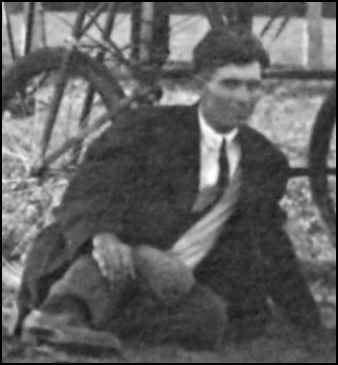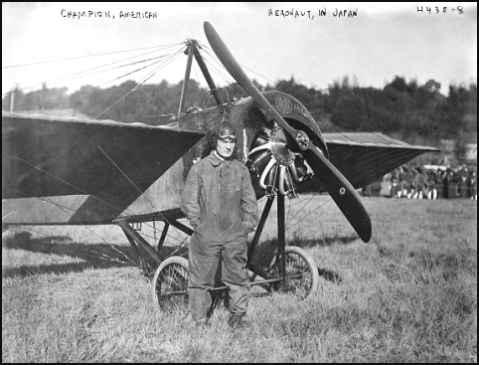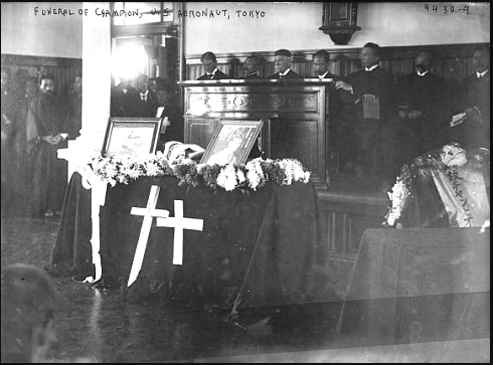
1884-1917 |
 |
Taken in Japan - 1917 Library of Congress Collection, 3-18-07 |
 |
Probably taken in 1912 when Champion was performing in Oklahoma City Photo and legend from Keith Tolman, 3-8-05 |
|
Oklahoma's "Forgotten" Aviator By Keith Tolman from The Oklahoma Aviator, Vol. 23, No. 3, (March, 2005). Frank L. Champion was born in Sherman, Texas, in 1884, but grew up on the farm his father homesteaded two miles south of Oklahoma City. Following graduation from Oklahoma City High School, the young Champion joined the navy and traveled much of the world. It was in France that he witnessed his first airplane flight, probably at the premier Rheims Aviation Meet of 1909. By 1910, Champion had found work as a professional photographer in Long Beach, California. One of his assignments was to cover America's first aviation extravaganza, the Dominguez Field Aviation Meet held near Los Angeles. There, Champion found himself rubbing elbows with such early aviation superstars as Glenn Curtiss, Charles F. Willard, and the "Incomparable" Lincoln Beachey, the acknowledged king of the early exhibition pilots. He also made the acquaintance of Louis Paulhan, the darling of French aviation circles. The period between 1910 and World War I was the era of exhibition flying, often referred to by aerospace historians as the "Gold Rush to the Clouds." Fame and fortune awaited aviators willing to demonstrate manned, heavier-than-air flight to an admiring and still incredulous public. Indeed, no county fair, founders' day celebration, or old soldiers' reunion was considered complete unless an exhibition flight was in the offing. Champion found himself bitten hard by the aviation "bug" while covering the Dominguez Field event, and he was soon on his way to Europe intent on learning to fly. He enrolled at the Bleriot Aviation School near London, England, and soon after his return to the United States in 1912 became the proud holder of Aero Club of America license number eighty-six. He quickly landed a job with the Moisant International Aviators, one of the premier exhibition companies of the period. Coincidentally, Champion's flying debut took place during September of 1912 in his home state of Oklahoma. When the star of the show was injured in a flying mishap, Champion filled in for him at the Tulsa State Fair. Later, during early October, he shared the attention of Oklahoma City crowds with former President Teddy Roosevelt, who was in town stumping for the Bull Moose Party. Proclaimed the "darling of the fliers," one newspaper reporter proudly wrote of Champion: "There is no stunt, dive, dip, whirl, ascension or speed trial that he will not attempt." During the engagement, he won the hearts of fellow Oklahomans by flying over his boyhood home located in the Capitol Hill section of Oklahoma City. The Moisant troop went on to fill other Oklahoma engagements that year. At McAlester Champion was scheduled to carry a passenger aloft, but weather conditions prevented him from making such a flight. Nevertheless, Champion thrilled the crowds by flying over the Oklahoma State Penitentiary, much to the delight of inmates staring from below. During subsequent flying seasons he appeared at the Oklahoma towns of Muskogee, Comanche, Ryan, Durant, and Maysville, as well as towns throughout the United States. In 1915, Champion formed his own exhibition company based in Kansas City, Missouri. By that time, however, exhibition flying had lost much of its thrill and seemed mundane compared to the do-or-die aerial feats taking place over the trenches of a war-torn Europe. Seeing the proverbial handwriting on the wall, in 1917 Champion packed up and headed for Asia, a continent where the airplane was still a novelty. |
 |
Photo from Phyllis Hays, 1-29-08 |
 |
 |
Photo from Phyllis Hays, 1-29-08 |
 |
Taken in Japan - 1917 Library of Congress Collection, 3-18-07 |
|
By the time Champion performed before the Emperor of Japan in early 1917 he had added the loop to
his aerobatic routine. He was performing the maneuver over Koghi, Japan, in July when a wing spar on his Bleriot failed sending the
Oklahoma flier plummeting 4,000-feet to his death. The entire population of the city turned out for his funeral and accompanied his
ashes in a colorful procession through the streets of the town. The Emperor honored the flier's memory by placing the 50-hp Gnome
rotary engine of his mangled monoplane on exhibit in the Imperial Palace in Tokyo. Frank Champion was one of those intrepid early pilots who brought the airplane before the public eye for the first time. Maybe Billy Parker was right and Champion deserves to have an Oklahoma airport named for him. When you think about it, "Champion Field" has a nice ring to it! |
|
The New York Herald September, 1911 TRUE TALES OF THE ANCIENT AVIATORS |
|
Editor's Note: These few introductory paragraphs come from an article on Earl Daugherty and the beginnings of the Long Beach airport. It is found on the website of the Long Beach Press-Telegram newspaper. It is reprinted by the kind permission of Carolyn Ruszkiewicz and the Long Beach Press-Telegram. The extensive article, which includes a complete biography of Earl, is replete with stories and photos which celebrated the 75th anniversary, (1923-1998), of the founding of the airport. I heartily recommend that you read it in its entirety by clicking on the title, |
|
courtesy of Steve Remington - CollectAir |
via email fromGary Couey, 4-25-08 I just ran across your article about Frank Champion on the earlyaviators website. Here is an additional tidbit for you. Champion's daughter, Jeannie Masculine (widow of my mother's cousin), was invited by the Japanese government to attend a ceremony honoring the 80th anniversary of Champion's death. She was flown over in first class by Japan Air Lines, and given the red carpet treatment throughout her visit there. At the end of the ceremony in Koghi, Japan, an old man came up to her and presented her one of Champion's flying boots. He had attended Champion's demonstration flight, saw the accident, and found the boot in a field. He had kept the boot as a souvenir. Your article didn't mention the following bit, so I provide it with some skepticism, since it is based on an old lady's memory. The fact that all the other details of her story agree with those in your article, however, lends it some credence in my mind. Jeannie told me that the U.S. government sent Champion to Japan to train Japanese aviators (which, if true, has to be one of history's most tragic ironies). She said that as he was preparing to leave Japan, the Japanese authorities prevailed upon him to perform one last demonstration flight for the public. It did indeed turn out to be the last flight. Sincerely, Gary Couey |
|
|
|
Earle C. Remington Early Los Angeles Sportsman Pilot and Naval Militia Aviator "In June, Bleriot pilot Frank Champion started flying Remington's other plane. Champion had just returned from England where he had graduated from the Bleriot Flying School. Following this, Remington and Champion (1) did some exhibition and cross-country in nearby areas." You can read the rest of the story by clicking on the title above. |
 |
Library of Congress Collection, 3-18-07 |
|
from Keith Tolman, 3-7-05 |
|
If you have any more information on this pioneer flyer, please contact me. E-mail to Ralph Cooper Back 

|